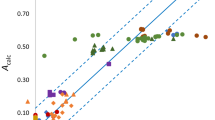Abstract
THE optical rotatory powers of steroidal compounds can be correlated by means of the method of molecular rotation differences, and such correlation has been shown to be of value in solving certain types of structural problem1. In some cases anomalies of optical rotatory power occur which cannot be ascribed to trivial causes, but which must be due to disturbing factors generally given the name 'vicinal action'.
Similar content being viewed by others
References
Barton, J. Chem. Soc., 813 (1945); 512, 1116 (1946). Compare Callow and Young, Proc. Roy. Soc., A, 157, 194 (1936); Kauzmann, Walter and Eyring, Chem. Rev., 26, 339 (1940); Wallis et al., J. Org. Chem., 6, 319 (1941); 7, 103 (1942).
Compare Wallis et al., loc. cit.
Author information
Authors and Affiliations
Rights and permissions
About this article
Cite this article
BARTON, D., COX, J. Vicinal Action in Steroids. Nature 159, 470–471 (1947). https://doi.org/10.1038/159470b0
Issue Date:
DOI: https://doi.org/10.1038/159470b0
- Springer Nature Limited
This article is cited by
-
Cholest-6-en-3(β )-ol
Nature (1949)





